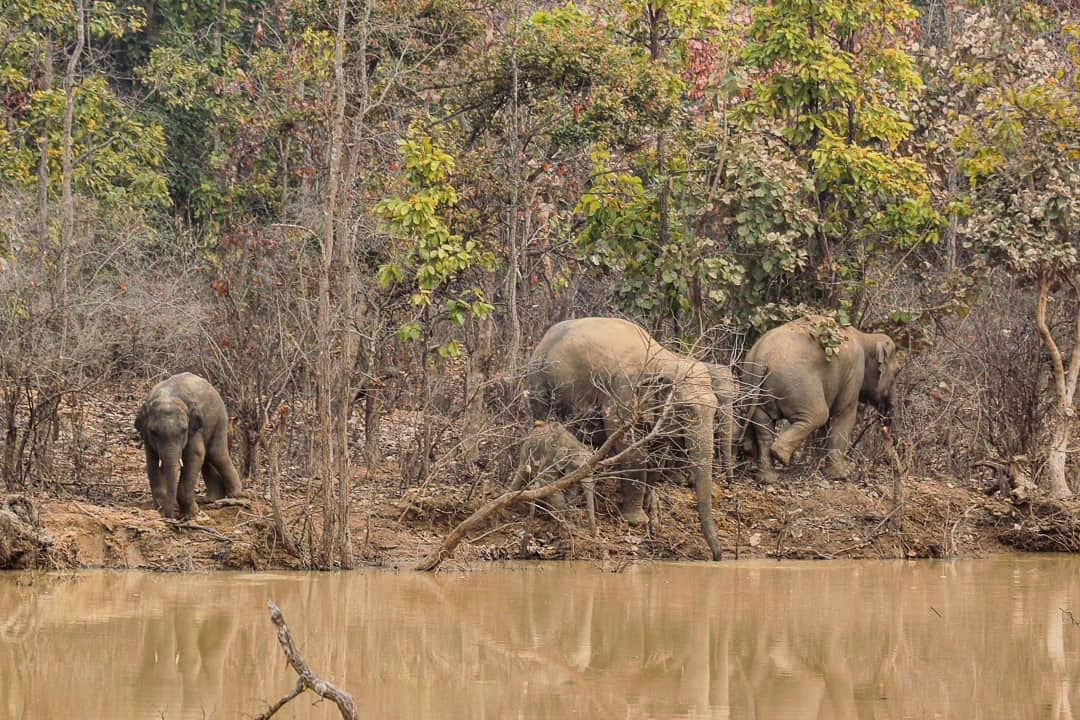The Northern Chhattisgarh landscape is located at the intersection of the Eastern Baghelkhand plateau and the Chhattisgarh plains. The region is drained by the Mahanadi and Son rivers. Geologically, it is composed of lower Gondwana and the eastern extension of the Deccan Peninsula. It is surrounded by the Chhota Nagpur and Hazaribaug plateaus, which are rich in coal deposits. Over this buried ‘black gold’ stand the tropical dry deciduous and mixed forests inhabited by a wide variety of wildlife, including elephants.
Elephants have inhabited this part of the country historically. However, since 2005-06, rapid deforestation and coal mining in Chhattisgarh and the neighbouring states of Jharkhand and Odisha have led to massive habitat deterioration. Consequently, elephants are being pushed out of their usual habitats and into sparsely forested and agrarian areas, leading to human-elephant conflict (HEC). “Earlier (a decade ago), elephants used to arrive in very small numbers during harvest, and the whole village would gather to see them. Many offered grains, coconuts and bananas to these elephants,” says Baru, aged 50, a resident of Rewatpur village of Surguja.
Rewat, 26, from the same village adds: “But now they have made this region their home. They raid the crops almost every night and also destroy houses and kill people. We can’t even sleep peacefully”. Government figures reveal that since 2010, 75 elephants have died, and the number of human casualties has reached 350. There have been more cases of housebreaking by elephants and numerous cases of crop raiding. A single raid can damage Rs. 15,000-20,000 worth of standing crops. A raid by big herds can be even more disastrous. In a region with very small landholdings, a loss of this magnitude can be 20-30% of a farmer’s income. This can lead to financial stress in agricultural households.
“We made a lot of requests to the Forest Department, but since they can’t kill elephants, we have learned to live with them,” says Sukhsagar, 30, from Bansipur village. The tolerance level of communities is not the same in all villages. It is influenced by the social, economic, and cultural back-ground of the communities residing in the village. People have accepted raiding as an inescapable consequence of growing sugarcane and wheat. However, the issue is much more complex and also involves displacement of herds from their original habitats due to mining. The inability to under-stand and deal with the HEC at a landscape level has caused the focus to shift to local interventions.
One of the most crucial interventions is through the formation of “Hathi Mitra Dal”, which is a Forest Department-led and community-supported program, wherein boys from the village patrol the affected areas in Forest Department vehicles during nighttime and alert people to the presence of elephants. These vehicles also help in safely escorting stranded motorcyclists and passersby, as well to drive elephants away when they enter houses in search of salt and lentils.
Another intervention that is saving many lives is the real-time monitoring of elephants through WhatsApp groups. Under a Wildlife Institute of India Project, a few individual elephants have been satellite-collared and their real-time locations are tracked in an elephant control room. From here the locations are shared with the concerned Forest Rangers of the area, who share it with villagers. The villagers further share it in small WhatsApp groups in their respective localities.
A third intervention that was conceived to ensure co-existence is a compensation program, through which the Forest Department pays for the damage done to crops and houses by elephants. Chhattisgarh Forest Department records show that Rs. 75 crores has been paid as compensation so far. However, like any other compensation program, it is also fraught with delayed cognizance, un-der-reporting, and inadequate compensation rates. “The muabja [compensation] is very low and takes a lot of time to come into our account, and sometimes a complete amount does not come,” says Jaitu Ram from Bansipur village.
In this landscape, which is a matrix of forest patches, water bodies, agricultural land, and human settlements, elephants use forest patches in the daytime and raid the agriculture fields during the night. The villagers are learning how to live with elephants, and are devising new ways of keeping their crops, houses, and children safe. Since there is no permanent solution to this complex problem, a multitude of interventions are needed at different scales.
On a larger scale, elephant habitats in Jharkhand and Odisha need to be protected. In conflict-ridden areas, villagers need to be made aware of elephant behavior and given adequate training and tools to deal with conflict situations. There are still large forested areas with ample forage and water in Northern Chhattisgarh, which can become a permanent refuge for elephants. Gradually driving elephants to these areas will require further studies on their behavior and a better understanding of the drivers of resource use in these landscapes. This can be achieved only when all stakeholders – locals, forest department, district administration, and the scientific community – come together and work in a coordinated manner.
References:
- https://www.indiatoday.in/india-today-insight/story/chhattisgarh-has-a-jumbo-problem-1691349-2020-06-22
- https://www.thehindu.com/news/national/human-elephant-conflict-kills-1713-people-373-pachyderms-in-3-years/article26225515.ece
- https://www.downtoearth.org.in/coverage/wildlife-biodiversity/jumbo-conflict-43530


 CI is a non-profit, non-commercial portal that aims to facilitate wildlife and nature conservation by providing reliable information and the tools needed to campaign effectively.
CI is a non-profit, non-commercial portal that aims to facilitate wildlife and nature conservation by providing reliable information and the tools needed to campaign effectively.